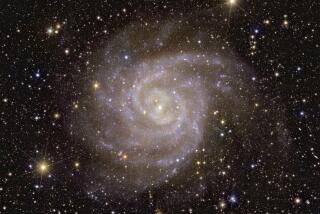Hubble Telescope Captures Stunning Formation of Stars
- Share via
Monstrous columns of cold gas and dust, captured in a stunning photograph by the Hubble Space Telescope, are giving scientists an unprecedented view of stars being formed “right in front of our eyes.”
The gaseous towers, 6 trillion miles long, resemble stalagmites rising from a cavern floor, or the heads of sea serpents. At their edges can be seen finger-like protrusions, each with tips larger than our solar system, in which stars are embedded.
The photographs, taken April 1 and released Thursday by the National Aeronautics and Space Administration, show about 50 stars that formed inside globules of especially dense molecular hydrogen gas. The stars were cradled in EGGs, or evaporating gaseous globules.
“This is the first time that we have actually seen the process of forming stars being uncovered by photoevaporation,” said astronomer Jeff Hester, the principal investigator, from the University of Arizona at Tempe.
“For a long time, astronomers have speculated why stars are the sizes they are,” Hester said. In the photographs, he said, “we seem to be watching at least one such process at work right in front of our eyes.”
Hester and his colleagues asked that the Hubble be aimed at the Eagle Nebula, a known star-forming region 7,000 light years away in the constellation Serpens.
Stars form in clouds so dense that the gas collapses under its own gravity. As they grow, the young stars spew large amounts of energy. Massive stars are very bright and very hot and produce huge amounts of intense ultraviolet radiation.
“That radiation hollows out a cavity around them when it heats their surroundings and clears them out,” Hester said.
The photograph shows a few very massive, very hot bright stars against a cavity.
“If you were to watch that over the course of a million years, you could see the cavity get bigger and bigger as radiation eats further into the cloud,” Hester explained. “As that cloud gets boiled away, it uncovers things buried there. In the case of M16 [another name for the nebula], it’s uncovering a region that is forming yet more stars; the cloud hasn’t all been eaten away.”
The pictures capture the stars before they finished forming.






